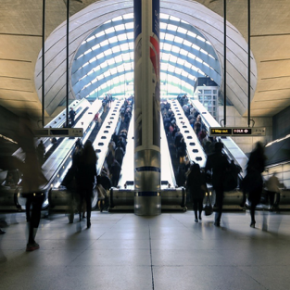
What will the impact of Crossrail be on the physical environment of London?
As far as infrastructure projects go, few if any in recent memory have been as ambitious as the Crossrail development.
Aiming to provide more than 1.5 million people with just a 45 minute commute to the heart of London via the all-new ‘Elizabeth’ line, Crossrail will extend the capital’s public transport network eastwards into Essex, and westwards towards Reading and Heathrow.
Scheduled to open in part next year in 2018 and fully in 2019, the £14.8 billion given over to the scheme has been earmarked for spending on ’42 kilometres of tunnels, 10 new stations, improvements to 30 more and upgrades to existing rail infrastructure’.
On the surface (or in this case under it), that all sounds pretty great. Investment in infrastructure is conducive to greater efficiency for people on the go, and will no doubt do wonders for the local economies situated near to the new stations born out of Crossrail’s development. But what could the environmental impact be?
First things first, it should be noted that Crossrail has always been constructed with environmental sustainability in mind, as their website points out within its own dedicated section. However whilst the plans may have sought to minimise the disruption on the environment, a project of such magnitude is always going to have some repercussions.
Most significantly, could be the fact that to clear the way for the Elizabeth line, approximately 26 miles of tunnels had to be excavated. Running under the centre of London, Crossrail may possibly have an effect on the buildings above that could be felt tomorrow, or never at all.
By tunnelling in some places close to water-bearing soil, the constant vibration of trains could perhaps disrupt this level of the underground and trigger instability up above. In turn, those structures on top of these instabilities could find their foundations compromised.
Unlike cities such as Tokyo or Los Angeles which require every building to be specially designed to cope in the event of a natural disaster, London has no such regulations.
Many of the more historic buildings in particular whilst often strengthened via modern building techniques could still be at risk to unheralded geographic changes, and no amount of planning can cover every possible eventuality.
A second impact can be seen within communities across the Crossrail route, as around 100 complaints a year have flooded in to protest the construction needed to get the line in place.
Just to move a single water pipe out of the way of the tunnel at Royal Victoria Dock proved to be a mammoth undertaking, and with no compensation for local residents.
Whilst such a disruption could perhaps be waved away as a one-time predicament, it is indicative of the issues that will no doubt arise when it comes to maintaining the line.
Whilst upkeep works to the Underground can be carried out far below the surface, the Overground section requires a more intrusive touch.
For the segments of Crossrail within densely populated areas, maintenance could be a highly intrusive issue, both physically and in terms of lights and noise at inopportune times of the day.
There is no real way around this issue, which could have a further knock-on effect on property prices and land values should they be labelled as sites of frequent disruption.
Yet overall, it is evident that despite some potential cause for concern down the line, this is an inevitable factor of living within any city.
Infrastructure always has to be updated at some point in its lifespan, and we should be thankful that such a large a project has such extensive Government oversight that will address even the most unlikely of consequences.
The benefits of Crossrail overall to local areas will outweigh any bouts of disruption, and hopefully will provide a new lease of life all along the Crossrail route.
Latest news

21st February 2025
ASSA ABLOY EMEIA: Save valuable time and money with a seamless switch to programmable digital keys
In 2025, access management can be a whole lot easier. By making access part of their digital processes, businesses can put time-consuming key management and the cost of changing the locks firmly behind them. Making this switch is a lot easier than many people think, as ASSA ABLOY explains here…
Posted in Access Control & Door Entry Systems, Architectural Ironmongery, Articles, Building Industry News, Building Products & Structures, Building Services, Doors, Facility Management & Building Services, Health & Safety, Information Technology, Innovations & New Products, Retrofit & Renovation, Security and Fire Protection
21st February 2025
Showersave supports industry leaders in addressing Part L and Part G regulations
Showersave has sponsored and participated in a recent Building Insights LIVE roundtable on ‘Water & Energy Saving Innovations in New Build Housing’.
Posted in Articles, Bathrooms & Toilets, Bathrooms, Bedrooms & Washrooms, Building Associations & Institutes, Building Industry Events, Building Industry News, Building Products & Structures, Building Regulations & Accreditations, Building Services, Exhibitions and Conferences, Interiors, Pipes & Fittings, Plumbing, Retrofit & Renovation, Sustainability & Energy Efficiency
21st February 2025
GEZE: The importance of Specifying High Quality Door Closers on Fire Doors
Andy Howland, Sales & Marketing Director at GEZE UK, discusses why specifying high quality door closers on fire doors is important…
Posted in Access Control & Door Entry Systems, Accessibility, Architectural Ironmongery, Articles, Building Industry News, Building Products & Structures, Building Regulations & Accreditations, Building Services, Doors, Facility Management & Building Services, Health & Safety, Posts, Restoration & Refurbishment, Retrofit & Renovation, Security and Fire Protection
21st February 2025
Insight Data achieves ISO9001 recertification with zero non-conformities
Leading industry data specialist, Insight Data, has successfully achieved the prestigious recertification for ISO9001 with zero non-conformities for the fourth consecutive year.
Posted in Articles, Building Industry News, Building Regulations & Accreditations, Building Services, Information Technology, Research & Materials Testing
 Sign up:
Sign up: